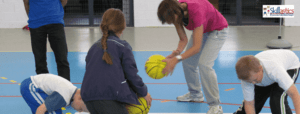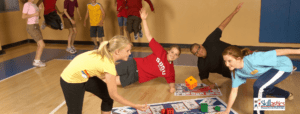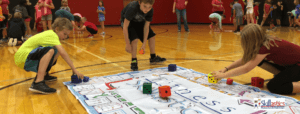Some educators use the words motivation and engagement interchangeably, but they’re very different. Motivation, from the Latin word motivus–meaning moving–is the force or thing that prompts you to act where engagement is a feeling of belonging, commitment, or purpose towards an organization or idea. To break it down even further, engagement is whether an individual feels like a contributing member of a team–that comes from the environment you create in your after school and club programs–where motivation drives the person to act on those feelings of belonging.
Motivation comes in two forms, according to a study from the University of Rochester in American Psychologist. Intrinsic motivation, where people are passionate about something because they enjoy it or have satisfaction and pride in achieving a goal. Conversely, extrinsic motivation comes from external forces–sometimes good and sometimes bad–where the individual is working only to receive praise or rewards (good) or to avoid punishment (bad).
So, what does that have to do with sports? Well, before you can look for ways to improve motivation, it’s important to see the difference between motivation and engagement, recognize how others are motivated, and determine what role we play in that as educators.
Extrinsic motivation like praise or rewards is great for team sports, however, you can’t realistically reward every kid every day with ribbons, plaques, and trophies. Not only is it outside of many organizational budgets, it also doesn’t mean as much if there’s a physical award every day. Instead, focus on intrinsic motivation, where kids are passionate about fitness as a result of enjoying an activity or reaching a goal using these seven key ingredients.
Variety: It really is the spice of life.
A Colorado University study found that students believe they either are or are not good at something. For instance, they either think they are or are not good at math, and their own perception has a direct effect on their persistence at trying to master math problems. Likewise, if students think they are not good at a physical activity, it can have a direct effect on whether they try hard to achieve goals, where kids who think they ARE good at a sport or activity would try harder to achieve them.
This is why it’s so critical to vary your sports, programs, and activities, so kids who feel they aren’t good at a particular sport or activity can easily transition to one that they like more! Offering variety gives each kid an opportunity to find something they’re good at. Skillastics® Activity Kits are designed with kids’ short attention spans and curiosity in mind. Each kit offers activities that sparks curiosity, allows engagement in a non-threatening atmosphere, and is a whole lot of fun.
Goals: Teach kids to set and reach them
Throughout the adolescent years, kids’ brains are constantly learning new things. One of the ways we can foster brain development is to encourage kids to set goals and reach them. When kids are striving for something new or making themselves better than a previous version of themselves, they become passionate about achieving that goal and jumping over the next hurdle. They can see their own progression both physically and mentally, and overcoming their obstacles helps carry that goal-setting mindset over to other areas of their lives.

Purpose: Help kids see why fitness matters
Kids like to know that what they’re doing makes a difference. When they learn how fitness affects their bodies both now and in the future, that can create motivation to exercise. Kids (and if we’re honest, adults too) like to know that their contribution matters. Make sure your program encourages kids to see how their personal contribution relates to the entire team as well as how it helps them meet their own body fitness goals. One way to consider this is to get their input! Asking why they think a skill matters or why fitness is important to them will help them find motivation through purpose.
Recognition: Mix in that extrinsic motivation now and then
Remember, kids love to be recognized for both their hard work toward an achievement as well as reaching the final achievement itself. Mix in a little extrinsic motivation in your regime. This can be as simple as verbal recognition of their efforts to paper awards or completion certificates, like martial arts belt level certificates. You can sometimes inspire kids by showing them what other kids have achieved and motivating them to achieve the same goal too. When you create an atmosphere where kids feel like their involvement can be recognized it can motivate them to keep going.

Involvement: Get their input
Ask kids what they want to learn about, what they’re curious about, and what they’d like to practice. Getting their input—and better yet, including this as a reward—shows kids that their opinion matters. For instance, the most helpful child could be asked to demonstrate how to perform their favorite game technique as a reward for helping others. When they feel like their opinion matters, that encourages them to be engaged in the group as a community and prompts them to take action! When the rest of their day is structured around rubrics, assessments, standards, and objectives, simply asking kids for their input allows kids to have some control over their environment and activities. The more control kids have, the more engaged they will be, and the more motivation they’ll have.
Set clear expectations
Kids won’t always get it right the first time, especially if they’re working towards a goal. You want them to have easy, quick wins, but you also want to give them a heads up that it may take a few tries to achieve or perfect a skill. This helps keep them from feeling defeated when they don’t make it on the first try and encourages them to keep going while they work on it.
Don’t forget to add in FUN!
At the end of the day, kids are kids! Encouraging them to have fun, be silly (can you make a funny face while doing those push-ups?) and get involved in physical activity allows them to have passion just because it’s fun and they enjoy it, not because it’s a requirement.
No matter what age group you have, kids need a reason to get involved. These key ingredients will Work together, be vested. Incorporating these key ingredients in your fitness program will give your kids everything they need to stay motivated and build the foundation they need for a fit life.





